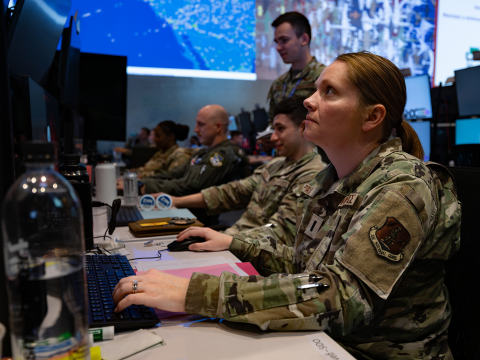The Human Element of Net Centricity
The U.S. Navy, master of the seas and leader in net centricity, faces an uncertain future in the very information technology applications it has led for years. If the Navy does not change its personnel system and its education system, then it will be a Navy that can maintain only information tools that are developed elsewhere and modified to fit the maritime role. Without a change in direction, our Navy will not be able to build and support the tools designed to serve the maritime warfighter from requirements development to acquisition.
In 1998, a new secretary of the Navy asked me what I thought about our Navy and the direction in which it was headed. I told him that in 10 years the Navy would look exactly the same as it did then. Taken aback, he asked why I thought that would come to pass, given all the investments we were making. My response was that the Navy’s personnel system was geared to institutionalizing the status quo and, whether by accident or design, tended to inoculate against change. It is our people, more than any technologies or platforms, that define our force.
Selection boards select individuals for promotion by looking at how much their careers resemble those of board members. The result is that the personnel system perpetuates the same career paths taken by others—even when the nature of combat, and of the Navy itself, is changing. And if the personnel system doesn’t change, the organization will not change.
I was obviously not alone in my concerns. Since those ancient times, precepts for selection boards have been written to include emphasis on nontraditional warfare areas such as education, technology and space qualifications.
These efforts have made some inroads. The Navy has an information professional community being populated by very bright people. But, the same problem that existed then exists today. Only the passage of time will determine when selection board precepts—along with the information professional community—will be able to influence the development of a professional core of information specialists in the Navy.
And make no mistake—information is changing the nature of combat and of the Navy. Our sister service, the U.S. Army, long has been equipped with an information-centric professional core. It’s called the Signal Corps, and for generations legions of communicators have been trained and educated at its headquarters in
That long-standing institution demonstrates that a precedent already has been set to educate and promote experts skilled in service-specific information technology disciplines. The Navy does not need to establish a facility similar to the
The Navy has been the leader in net centricity among the world’s militaries, and it has a requirement for a professional core with a career path that provides for upward mobility similar to the aviation, submarine and surface communities. This development is past due. The Navy must pay a great deal of attention to the uniformed professionals who will be the architects of its net-centric future.
This is not to say that the Navy lacks good information technology people—far from it. Sailors have much to be proud of in terms of being able to fix information systems on a small or local scale. These trained experts go to sea to spend their time imparting their skills on a tactical level. But they also deserve help from uniformed people educated in designing and managing higher level systems and their architectures. Outsourcing or adding a civilian support layer is not the course to take. We have the people within the Navy who can do the job; now let’s empower them with knowledge to do it.
One place to start is that selection board. Navy information technology careerists should be promoted on the basis of their abilities to design, develop and acquire net-centric equipment. This would ensure that the best expertise—particularly, the expertise needed for a rapidly evolving technology environment—rises to the top.
But the key to achieving this goal is education. The Navy does not spend enough time educating its personnel in this key specialty area.
Our senior uniformed information technology people have not been given enough education in the requirements that go with acquisition and architectures. The Navy must take a hard look at the educational pipelines for information technology that are available today—especially in light of the Navy’s net-centric character. Junior officer, mid-grade officer and senior officer levels all have new needs that have emerged with net centricity.
Navy personnel are the key to future net centricity. If the goal is to give the maritime warfighter the right equipment in the right place at the right time, then giving the right people the right education begins now.



Comments